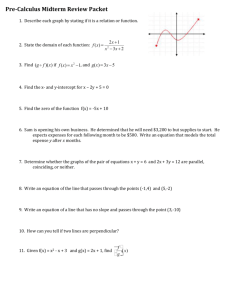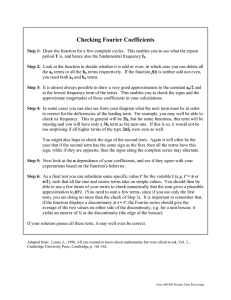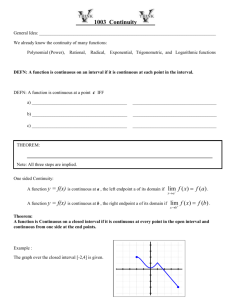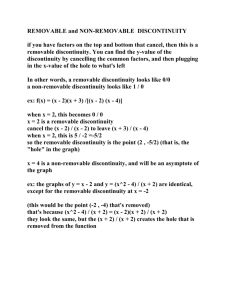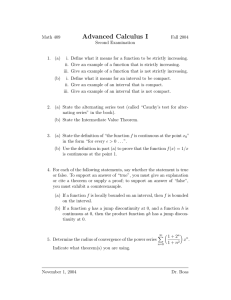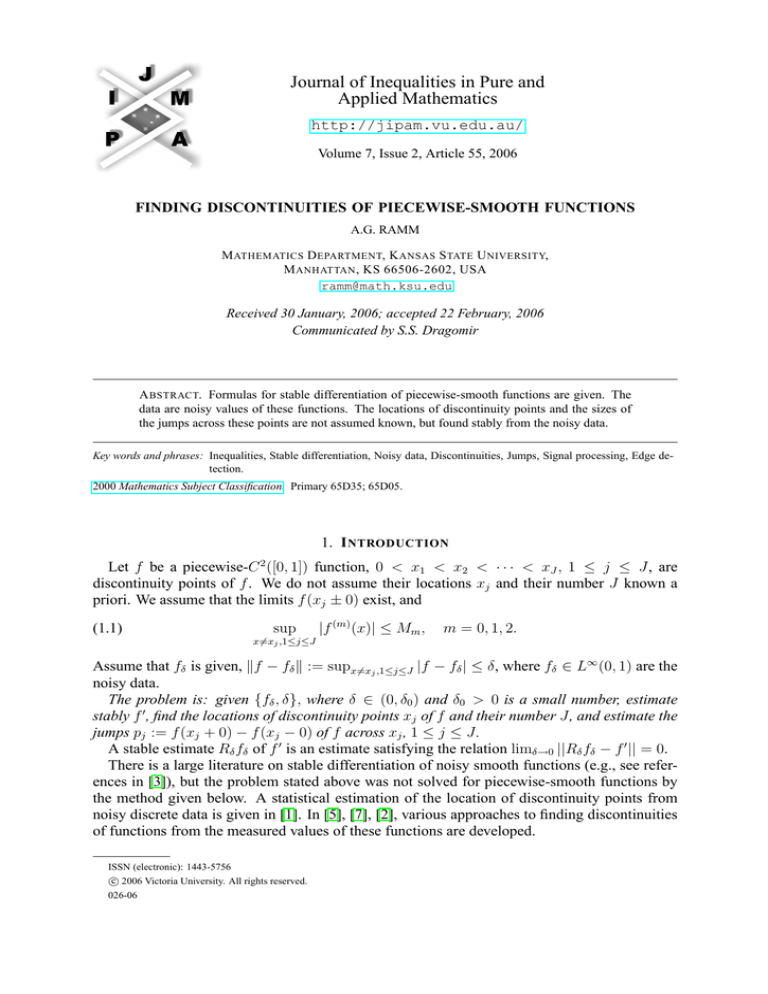
Journal of Inequalities in Pure and
Applied Mathematics
http://jipam.vu.edu.au/
Volume 7, Issue 2, Article 55, 2006
FINDING DISCONTINUITIES OF PIECEWISE-SMOOTH FUNCTIONS
A.G. RAMM
M ATHEMATICS D EPARTMENT, K ANSAS S TATE U NIVERSITY,
M ANHATTAN , KS 66506-2602, USA
ramm@math.ksu.edu
Received 30 January, 2006; accepted 22 February, 2006
Communicated by S.S. Dragomir
A BSTRACT. Formulas for stable differentiation of piecewise-smooth functions are given. The
data are noisy values of these functions. The locations of discontinuity points and the sizes of
the jumps across these points are not assumed known, but found stably from the noisy data.
Key words and phrases: Inequalities, Stable differentiation, Noisy data, Discontinuities, Jumps, Signal processing, Edge detection.
2000 Mathematics Subject Classification. Primary 65D35; 65D05.
1. I NTRODUCTION
Let f be a piecewise-C 2 ([0, 1]) function, 0 < x1 < x2 < · · · < xJ , 1 ≤ j ≤ J, are
discontinuity points of f . We do not assume their locations xj and their number J known a
priori. We assume that the limits f (xj ± 0) exist, and
(1.1)
sup
|f (m) (x)| ≤ Mm ,
m = 0, 1, 2.
x6=xj ,1≤j≤J
Assume that fδ is given, kf − fδ k := supx6=xj ,1≤j≤J |f − fδ | ≤ δ, where fδ ∈ L∞ (0, 1) are the
noisy data.
The problem is: given {fδ , δ}, where δ ∈ (0, δ0 ) and δ0 > 0 is a small number, estimate
stably f 0 , find the locations of discontinuity points xj of f and their number J, and estimate the
jumps pj := f (xj + 0) − f (xj − 0) of f across xj , 1 ≤ j ≤ J.
A stable estimate Rδ fδ of f 0 is an estimate satisfying the relation limδ→0 ||Rδ fδ − f 0 || = 0.
There is a large literature on stable differentiation of noisy smooth functions (e.g., see references in [3]), but the problem stated above was not solved for piecewise-smooth functions by
the method given below. A statistical estimation of the location of discontinuity points from
noisy discrete data is given in [1]. In [5], [7], [2], various approaches to finding discontinuities
of functions from the measured values of these functions are developed.
ISSN (electronic): 1443-5756
c 2006 Victoria University. All rights reserved.
026-06
2
A.G. R AMM
The following formula was proposed originally (in 1968, see [4], and [3]) for stable estimation of f 0 (x), assuming f ∈ C 2 ([0, 1]), M2 6= 0, and given noisy data fδ :
1
2δ 2
fδ (x + h(δ)) − fδ (x − h(δ))
(1.2) Rδ fδ :=
, h(δ) :=
, h(δ) ≤ x ≤ 1 − h(δ),
2h(δ)
M2
and
(1.3)
kRδ fδ − f 0 k ≤
p
2M2 δ := ε(δ),
where the norm in (1.3) is the L∞ (0, 1)−norm. The numerical efficiency and stability of the
stable differentiation method proposed in [4] has been demonstrated in [6]. Moreover, (cf [3]),
(1.4)
inf
sup
T f ∈K(M2 ,δ)
kT fδ − f 0 k ≥ ε(δ),
where T : L∞ (0, 1) → L∞ (0, 1) runs through the set of all bounded operators, K(M2 , δ) :=
{f : kf 00 k ≤ M2 , kf − fδ k ≤ δ}. Therefore (1.2) is the best possible estimate of f 0 , given
noisy data fδ , and assuming f ∈ K(M2 , δ).
In [3] this result was generalized to the case f ∈ K(Ma , δ), kf (a) k ≤ Ma , 1 < a ≤ 2,
0 (x)−f 0 (x0 )|
(a)
is the fractional-order
where kf (a) k := kf k + kf 0 k + supx,x0 |f |x−x
0 |a−1 , 1 < a ≤ 2, and f
derivative of f .
The aim of this paper is to extend the above results to the case of piecewise-smooth functions.
In Section 2 the results are formulated, and proofs are given. In Section 3 the case of continuous
piecewise-smooth functions is treated.
2. F ORMULATION
OF THE
R ESULT
Theorem 2.1. Formula (1.2) gives stable estimate of f 0 on the set
- J
[
Sδ := [h(δ), 1 − h(δ)]
(xj − h(δ), xj + h(δ)) ,
j=1
and (1.3) holds with the norm k · k taken on the set Sδ . Assuming M2 > 0 and computing the
12
fδ (jh+h)−fδ (jh−h)
2δ
quantities fj :=
, where h := h(δ) := M
, 1 ≤ j < [ h1 ], for sufficiently
2h
2
small δ, one finds the location of discontinuity points of f with accuracy 2h, and their number
J. Here [ h1 ] is the integer smaller than h1 and closest to h1 . The discontinuity points of f are
located on the intervals (jh − h, jh + h) such that |fj | 1 for sufficiently small δ, where ε(δ)
is defined in (1.3). The size pj of the jump of f across the discontinuity point xj√is estimated by
the formula pj ≈ fδ (jh + h) − fδ (jh − h), and the error of this estimate is O( δ).
Let us assume that minj |pj | := p h(δ), where means "much greater than". Then xj is
located on the j th interval [jh − h, jh + h], h := h(δ), such that
fδ (jh + h) − fδ (jh − h) 1,
(2.1)
|fj | := 2h
so that xj is localized with the accuracy 2h(δ). More precisely, |fj | ≥
δ
= 0.5ε(δ), where ε(δ) is defined in (1.3). One has
h
|f (jh+h)−f (jh−h)|
2h
− hδ , and
|f (jh + h) − f (jh − h)| ≥ |pj | − |f (jh + h) − f (xj + 0)| − |f (jh − h) − f (xj − 0)|
≥ |pj | − 2M1 h.
J. Inequal. Pure and Appl. Math., 7(2) Art. 55, 2006
http://jipam.vu.edu.au/
F INDING D ISCONTINUITIES OF P IECEWISE - SMOOTH F UNCTIONS
3
Thus,
|fj | ≥
|pj |
|pj |
− M1 − 0.5ε(δ) = c1 √ − c2 1,
2h
δ
√
M2
where c1 := 2√
, and c2 := M1 + 0.5ε(δ).
2
The jump pj is estimated by the formula:
(2.2)
pj ≈ [fδ (jh + h) − fδ (jh − h)],
and the error estimate of this formula can be given:
r
(2.3)
|pj − [fδ (jh + h) − fδ (jh − h)]| ≤ 2δ + 2M1 h = 2δ + 2M1
√
2δ
= O( δ).
M2
1
Thus, the error of the calculation of pj by the formula pj ≈ fδ (jh + h) − fδ (jh − h) is O(δ 2 )
as δ → 0.
Proof of Theorem 2.1. If x ∈ Sδ , then using Taylor’s formula one gets:
(2.4)
|(Rδ fδ )(x) − f 0 (x)| ≤
δ M2 h
+
.
h
2
Here we assume that M2 > 0 and the interval (x − h(δ), x + h(δ)) ⊂ Sδ , i.e., this interval
does not contain discontinuity points of f . If, for all sufficiently small h, not necessarily for
h = h(δ), inequality (2.4) fails, i.e., if |(Rδ fδ )(x) − f 0 (x)| > hδ + M22 h for all sufficiently small
h > 0, then the interval (x − h, x + h) contains a point xj 6∈ Sδ , i.e., a point of discontinuity of
f or f 0 . This observation can be used for locating the position of an isolated discontinuity point
xj of f with any desired accuracy provided that the size |pj | of the jump of f across xj is greater
than 4δ, |pj | > 4δ, and that h can be taken as small as desirable. Indeed, if xj ∈ (x − h, x + h),
then we have
|pj | − 2hM1 − 2δ ≤ |fδ (x + h) − fδ (x − h)| ≤ |pj | + 2hM1 + 2δ.
The above estimate follows from the relation
|fδ (x + h) − fδ (x − h)|
= |f (x + h) − f (xj + 0) + pj + f (xj − 0) − f (x − h) ± 2δ|
= ||pj | ± (2hM1 + 2δ)|.
Here |p ± b|, where b > 0, denotes a quantity such that |p| − b ≤ |p ± b| ≤ |p| + b. Thus, if h
is sufficiently small and |pj | > 4δ, then the inequality 2δ − 2hM1 ≤ |fδ (x + h) − fδ (x − h)|
can be checked, and therefore the inclusion xj ∈ (x − h, x + h) can be checked. Since h > 0
is arbitrarily small in this argument, it follows that the location of the discontinuity point xj of
f is established with arbitrary accuracy. Additional discussion of the case when a discontinuity
point xj belongs to the interval (x − h(δ), x + h(δ)) will be given below.
Minimizing the right-hand side of (2.4) with respect to h yields formula (1.2) for the minimizer h = h(δ) defined in (1.2), and estimate (1.3) for the minimum of the right-hand side of
(2.4).
If p h(δ), and (2.1) holds, then the discontinuity points are located with the accuracy
2h(δ), as we prove now.
Consider the case when a discontinuity point xj of f belongs to the interval (jh − h, jh + h),
where h = h(δ). Then estimate (2.2) can be obtained as follows. For jh − h ≤ xj ≤ jh + h,
J. Inequal. Pure and Appl. Math., 7(2) Art. 55, 2006
http://jipam.vu.edu.au/
4
A.G. R AMM
one has
|f (xj + 0) − f (xj − 0) − fδ (jh + h) + fδ (jh − h)|
≤ 2δ + |f (xj + 0) − f (jh + h)| + |f (xj − 0) − f (jh − h)|
≤ 2δ + 2hM1 ,
h = h(δ).
This yields formulas (2.2) and (2.3). Computing the quantities fj for 1 ≤ j < [ h1 ], and finding
the intervals on which (2.1) holds for sufficiently small δ, one finds the location of discontinuity
points of f with accuracy 2h, and the number J of these points. For a small fixed δ > 0
|p |
the above method allows one to recover the discontinuity points of f at which |fj | ≥ 2hj −
√
δ
− M1 1. This is the inequality (2.1). If h = h(δ), then hδ = 0.5ε(δ) = O( δ), and
h
√
|2hfj − pj | = O( δ) as δ → 0 provided that M2 > 0. Theorem 2.1 is proved.
Remark 2.2. Similar results can be derived if kf (a) kL∞ (Sδ ) := kf (a) kSδ ≤ Ma , 1 < a ≤ 2. In
h
i a1
1
2
this case h = h(δ) = ca δ a , where ca = Ma (a−1)
, Rδ fδ is defined in (1.2), and the error of
the estimate is:
a−1
a
1
a−1
2
0
kRδ fδ − f kSδ ≤ aMaa
δ a .
a−1
The proof is similar to that given in Section 3. It is proved in [3] that for C a -functions given
with noise it is possible to construct stable differentiation formulas if a > 1 and it is impossible
to construct such formulas if a ≤ 1. The obtained formulas are useful in applications. One can
also use the Lp -norm on Sδ in the estimate kf (a) kSδ ≤ Ma (cf. [3]).
Remark 2.3. The case when M2 = 0 requires a special discussion. In this case the last term on
the right-hand side of formula (2.4) vanishes and the minimization with respect to h becomes
void: it requires that h be as large as possible, but one cannot take h arbitrarily large because
estimate (2.4) is valid only on the interval (x − h, x + h) which does not contain discontinuity
points of f , and these points are unknown. If M2 = 0, then f is a piecewise-linear function. The
discontinuity points of a piecewise-linear function can be found if the sizes |pj | of the jumps
of f across these points satisfy the inequality |pj | 2δ + 2M1 h for some choice of h. For
instance, if h = Mδ1 , then 2δ + 2M1 h = 4δ. So, if |pj | 4δ, then the location of discontinuity
points of f can be found in the case when M2 = 0. These points are located on the intervals for
which |fδ (jh + h) − fδ (jh − h)| 4δ, where h = Mδ1 .
The size |pj | of the jump of f across a discontinuity point xj can be estimated by formula
(2.2) with h = Mδ1 , and one assumes that xj ∈ (jh − h, jh + h) is the only discontinuity point
on this interval. The error of the formula (2.2) is estimated as in the proof of Theorem 2.1. This
error is not more than 2δ + 2M1 h = 4δ for the above choice of h = Mδ1 .
One can estimate the derivative of f at the point of smoothness of f assuming M2 = 0
provided that this derivative is not too small. If M2 = 0, then f = aj x + bj on every interval ∆j
between the discontinuity points xj , where aj and bj are some constants. If (jh − h, jh + h) ⊂
δ (jh−h)
∆j , and fj := fδ (jh+h)−f
, then |fj − aj | ≤ hδ . Choose h = Mtδ1 , where t > 0 is a
2h
parameter, and M1 = maxj |aj |. Then the relative error of the approximate formula aj ≈ fj for
|f −a |
M1
the derivative f 0 = aj on ∆j equals to j|aj | j ≤ t|a
. Thus, if, e.g., |aj | ≥ M21 and t = 20, then
j|
the relative error of the above approximate formula is not more than 0.1.
J. Inequal. Pure and Appl. Math., 7(2) Art. 55, 2006
http://jipam.vu.edu.au/
F INDING D ISCONTINUITIES OF P IECEWISE - SMOOTH F UNCTIONS
5
3. C ONTINUOUS P IECEWISE - SMOOTH F UNCTIONS
Suppose now that ξ ∈ (mh − h, mh + h), where m > 0 is an integer, and ξ is a point at
which f is continuous but f 0 (ξ) does not exist. Thus, the jump of f across ξ is zero, but ξ is not
a point of smoothness of f . How does one locate the point ξ?
The algorithm we propose consists of the following. We assume that M2 > 0q
on Sδ . Calculate
fδ (jh+h)−fδ (jh−h)
2δ
the numbers fj :=
. Inequality
and |fj+1 − fj |, j = 1, 2, . . . , h = h(δ) = M
2h
2
(1.3) implies fj − ε(δ) ≤ f 0 (jh) ≤ fj + ε(δ), where ε(δ) is defined in (1.3).
Therefore, if |fj | > ε(δ), then sgn fj = sgn f 0 (jh).
One has:
2δ
2δ
J−
≤ |fj+1 − fj | ≤ J + ,
h
h
f (jh+2h)−f (jh)−f (jh+h)+f (jh−h)
δ
where h = 0.5ε(δ) and J := |
|. Using Taylor’s formula, one
2h
derives the estimate:
(3.1)
0.5[J1 − ε(δ)] ≤ J ≤ 0.5[J1 + ε(δ)],
where J1 := |f 0 (jh + h) − f 0 (jh)|.
If the interval (jh−h, jh+2h) belongs to Sδ , then J1 = |f 0 (jh+h)−f 0 (jh)| ≤ M2 h = ε(δ).
In this case J ≤ ε(δ), so
(3.2)
|fj+1 − fj | ≤ 2ε(δ)
if
(jh − h, jh + 2h) ⊂ Sδ .
Conclusion: If |fj+1 − fj | > 2ε(δ), then the interval (jh − h, jh + 2h) does not belong to Sδ ,
that is, there is a point ξ ∈ (jh − h, jh + 2h) at which the function f is not twice continuously
differentiable with |f 00 | ≤ M2 . Since we assume that either at a point ξ the function is twice
differentiable, or at this point f 0 does not exist, it follows that if |fj+1 − fj | > 2ε(δ), then there
is a point ξ ∈ (jh − h, jh + 2h) at which f 0 does not exist.
If
fj fj+1 < 0,
(3.3)
and
min(|fj+1 |, |fj |) > ε(δ),
(3.4)
then (3.3) implies f 0 (jh)f 0 (jh + h) < 0, so the interval (jh, jh + h) contains a critical point ξ
of f , or a point ξ at which f 0 does not exist. To determine which one of these two cases holds,
let us use the right inequality (3.1). If ξ is a critical point of f and ξ ∈ (jh, jh + h) ⊂ Sδ , then
J1 ≤ ε(δ), and in this case the right inequality (3.1) yields
|fj+1 − fj | ≤ 2ε(δ).
(3.5)
Conclusion: If (3.3) – (3.5) hold, then ξ is a critical point. If (3.3) and (3.4) hold and |fj+1 −
fj | > ε(δ) then ξ is a point of discontinuity of f 0 .
If ξ is a point of discontinuity of f 0 , we would like to estimate the jump
P := |f 0 (ξ + 0) − f 0 (ξ − 0)|.
Using Taylor’s formula one gets
P
± 2.5ε(δ).
2
The expression A = B ± b, b > 0, means that B − b ≤ A ≤ B + b. Therefore,
(3.6)
fj+1 − fj =
(3.7)
P = 2(fj+1 − fj ) ± 5ε(δ).
We have proved the following theorem:
J. Inequal. Pure and Appl. Math., 7(2) Art. 55, 2006
http://jipam.vu.edu.au/
6
A.G. R AMM
Theorem 3.1. If ξ ∈ (jh − h, jh + 2h) is a point of continuity of f and |fj+1 − fj | > 2ε(δ),
then ξ is a point of discontinuity of f 0 . If (3.3) and (3.4) hold, and |fj+1 − fj | ≤ 2ε(δ), then ξ
is a critical point of f . If (3.3) and (3.4) hold and |fj+1 − fj | > 2ε(δ), then ξ ∈ (jh, jh + h) is
a point of discontinuity of f 0 . The jump P of f 0 across ξ is estimated by formula (3.7).
4. F INDING N ONSMOOTHNESS P OINTS OF P IECEWISE - LINEAR F UNCTIONS
Assume that f is a piecewise-linear function on the interval [0, 1] and 0 < x1 < · · · < xJ < 1
are its nonsmoothness points, i.e, the discontinuity points of f or those of f 0 . Assume that fδ
is known at a grid mh, m = 0, 1, 2, . . . , M , h = M1 , fδ,m = fδ (mh), |f (mh) − fδ,m | ≤ δ ∀m,
fm = f (mh). If mh is a discontinuity point, mh = xj , then we define its value as f (xj − 0) or
f (xj + 0), depending on which of these two numbers satisfy the inequalty |f (mh) − fδ,m | ≤ δ.
The problem is: given fδ,m ∀m, estimate the location of the discontinuity points xj , their
number J, find out which of these points are points of discontinuity of f and which are points
of discontinuity of f 0 but points of continuity of f , and estimate the sizes of the jumps pj =
|f (xj + 0) − f (xj − 0)| and the sizes of the jumps qj = |f 0 (xj + 0) − f 0 (xj − 0)| at the continuity
points of f which are discontinuity points of f 0 .
Let us solve this problem. Consider the quantities
Gm :=
fδ,m+1 − 2fδ,m + fδ,m−1
= gm + wm ,
2h2
where
gm :=
fm+1 − 2fm + fm−1
,
2h2
wm :=
fδ,m+1 − fm+1 − 2(fδ,m − fm ) + fδ,m−1 − fm
.
2h2
We have
|wm | ≤
4δ
2δ
= 2,
2
2h
h
and
gm = 0 if xj 6∈ (mh − h, mh + h) ∀j.
Therefore, if minj |xj+1 − xj | > 2h and
2δ
,
h2
then the interval (mh − h, mh + h) must contain a discontinuity point of f . This condition
is sufficient for the interval (mh − h, mh + h) to contain a discontinuity point of f , but not
a necessary one: it may happen that the interval (mh − h, mh + h) contains more than one
discontinuity point without changing gm or Gm , so that one cannot detect these points by the
above method. We have proved the following result.
(4.1)
|Gm | >
Theorem 4.1. Condition (4.1) is a sufficient condition for the interval (mh − h, mh + h) to
contain a nonsmoothness point of f . If one knows a priori that xj+1 − xj > 2h then condition
(4.1) is a necessary and sufficient condition for the interval (mh − h, mh + h) to contain exactly
one point of nonsmoothness of f .
Let us estimate the size of the jump pj . Let us assume that (4.1) holds, xj+1 − xj > 2h and
xj ∈ (mh−h, mh). The case when xj ∈ (mh, mh+h) is treated similarly. Let f (x) = aj x+bj
when mh < x < xj , and f (x) = aj+1 x + bj+1 when xj < x < (m + 1)h, where aj , bj are
constants. One has
−(aj+1 − aj )(mh − h) − (bj+1 − bj )
,
gm =
2h2
J. Inequal. Pure and Appl. Math., 7(2) Art. 55, 2006
http://jipam.vu.edu.au/
F INDING D ISCONTINUITIES OF P IECEWISE - SMOOTH F UNCTIONS
7
and
pj = |(aj+1 − aj )xj + bj+1 − bj |.
Thus
−(aj+1 − aj )xj − (bj+1 − bj ) − (aj+1 − aj )(mh − h − xj ) |gm | = 2h2
|aj+1 − aj ||xj − (mh − h)|
pj
±
,
2
2h
2h2
where the symbol a ± b means a − b ≤ a ± b ≤ a + b. The quantity |aj+1 − aj | = qj , and
|xj − (mh − h)| ≤ h if mh − h < xj < mh.
Thus,
pj
qj h 2δ
|Gm | = 2 ±
+
,
2h
2h2 h2
and
pj
qj h + 4δ
|Gm | = 2 1 ±
,
2h
pj
provided that pj > 0.
If
qj h + 4δ
1 and pj > 0,
pj
then
pj ≈ 2h2 |Gm |.
If pj = 0 then
qj
2δ
|Gm | =
± 2.
2h h
Thus,
qj ≈ 2h|Gm |.
Finally, the number of the nonsmoothness points of f can be determined as the number of
intervals on which (4.1) holds.
=
R EFERENCES
[1] A.I. KATSEVICH AND A.G. RAMM, Nonparametric estimation of the singularities of a signal from
noisy measurements, Proc. Amer. Math. Soc., 120(8) (1994), 1121–1134.
[2] A.I. KATSEVICH AND A.G. RAMM, Multidimensional algorithm for finding discontinuities of
functions from noisy data, Math. Comp. Modelling, 18(1) (1993), 89–108.
[3] A.G. RAMM, Inverse Problems, Springer, New York, 2005.
[4] A.G. RAMM, On numerical differentiation, Mathematics, Izvestija VUZOV, 11 (1968), 131–135.
[5] A.G. RAMM AND A.I. KATSEVICH, The Radon Transform and Local Tomography, CRC Press,
Boca Raton, 1996.
[6] A.G. RAMM AND A. SMIRNOVA, On stable numerical differentiation, Math. of Comput., 70
(2001), 1131–1153.
[7] A.G. RAMM AND A.ZASLAVSKY, Reconstructing singularities of a function given its Radon transform, Math. Comp. Modelling, 18(1) (1993), 109–138.
J. Inequal. Pure and Appl. Math., 7(2) Art. 55, 2006
http://jipam.vu.edu.au/

